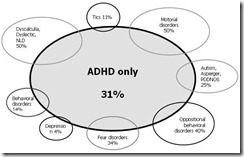
Attention Deficit Hyperactivity Disorder (ADHD) is a mystical diagnosis to many South Asian parents who are convinced that their child is just lazy, unmotivated or being defiant. While the diagnosis can be handed out far too easily for children who can’t sit still for as long as an adult needs them to sit, ADHD is a neurobiological disorder that is very real and most often life-long.
While the specific cause is not known yet, there are a number of risk factors that have been repeatedly supported by research as leading to the development of ADHD. First and foremost, ADHD has a strong genetic component. The severity of the disorder can vary between generations as can the specific presentation of symptoms (e.g. a parent may have trouble focusing but the child may exhibit more hyperactive symptoms) but numerous studies have pointed to a strong familial link. The link is not tied to just parents, as ADHD can skip generations as well so symptoms can be present in a grandparent, not in a child, and then resurface in the grandchild.
People with ADHD also tend to have an overall smaller brain size with specific regions, such as the frontal lobe, significantly smaller than people without ADHD. Directionality cannot be determined, meaning researchers are not sure if children with ADHD are born with a smaller brain size or if the lack of usage of certain parts of the brain results in shrinking. Certain neurotransmitter pathways have been shown to not function properly in the brains of children and adults with ADHD as well.
Maternal drug and alcohol use as well as cigarette smoking and lead exposure while pregnant has also connected to the development of ADHD in children. In addition, low birth weight as also been associated with a higher risk of developing ADHD. Children with ADHD are very commonly seen to also be living with a learning disability, anxiety and depression. Again, directionality is not clear but if ADHD is present, there is a high possibility that one of these mental health issues will be present as well and vice versa.
Contrary to popular belief, foods high in sugar and additives have not been shown to cause ADHD. Current research is pointing to food dyes and other preservatives acting to exacerbate an already present condition.
ADHD has become a label placed on children who cannot sit still or adults who seem scattered. While these lay definitions of the disorder are far from the reality, ADHD is a diagnosis that should be taken seriously. If given by mistake, a child or adult may end up taking unnecessary medications that might worsen other underlying conditions that are resulting in their symptoms that mimic ADHD. If the diagnosis is made properly, children can live to be healthy, functioning adults who are extremely successful academically and professionally.
Read about some of the common presentations of ADHD in South Asian children.
What questions, thoughts or comments do you have about ADHD? We would love to hear from you!
